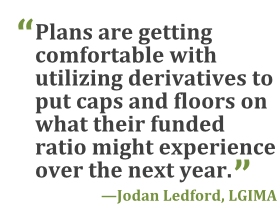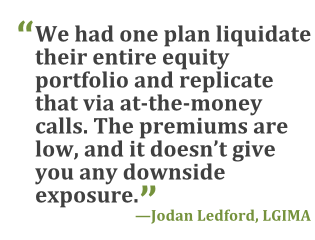 In 2013, the funded status improved dramatically for most pension plans inthe United States. Still, many analysts expect pension de-riskingto continue this year. Some plan sponsors will likely offerlump-sum buyouts to participants. Others are reconsidering theirasset allocations.
In 2013, the funded status improved dramatically for most pension plans inthe United States. Still, many analysts expect pension de-riskingto continue this year. Some plan sponsors will likely offerlump-sum buyouts to participants. Others are reconsidering theirasset allocations.
To get a handle on current trends in pension plan riskmanagement, Treasury & Risk sat down withJodan Ledford, head of U.S. solutions for Legal & GeneralInvestment Management America (LGIMA), a Chicago-based firm thatmanages fixed-income solutions for institutional investors. Theorganization also helps plan sponsors implement liability-driveninvestment (LDI) strategies, which focus on investing plan assetsin vehicles that will optimally mitigate the risks inherent in theplan's liabilities.
|T&R: First of all, what trendsdid you see in U.S.-based companies' pension plans in2013?
|Jodan Ledford: The biggest trend,obviously, was the funded ratio improvement. But we saw othertrends as well. Being on the front lines of LDI, we saw strongflows into more long-duration corporate fixed income. As plansbecame better-funded, they started reallocating from what wetypically call 'return-seeking assets' into more 'liability hedgingassets.' We saw more clients moving down their glide path. That waspretty consistent throughout Q3 and Q4 of 2013.
|T&R: When you use the term 'glidepath,' does that refer to establishing guidelines for shiftingasset allocations based on the plan's funded status?
|JL: That's correct. It effectively meansreallocating between return seeking and liability hedging toachieve the plan's objectives; the glide path really depends onwhat the plan's end-state goal is. For example, the typical closedand frozen plan, a plan that the company really has no desire tokeep in its balance sheet, would be looking to glide into a 115percent funded status on a GAAP [Generally Accepted AccountingPrinciples] basis to try to effect a risk transfer. So it wouldwant to customize the amount of return-seeking assets it holds ateach step along the way.
Another trend we saw in 2013 was that as plans becamebetter-funded and hit a 90 percent funded ratio on a GAAP basis, alot of them started to become interested in customized solutions.They're looking to mark their liability-hedging assets against theactual liability return versus just the return of a Barclays index.At the beginning of 2013, when most plans were somewhere around 75percent funded, plan sponsors' first-order concern was to getlonger durations. They were looking to invest in assets that wouldhave roughly the same duration as their liabilities. They startedmoving into longer-duration fixed-income assets. Then, as theyreallocated out of equity risks, their first-order concern becamerefining their liability-hedging assets so that they would movemore in line with the liabilities. They started looking at makingsure their liabilities' sensitivities to changes in interest ratesaligned with their assets' sensitivities to changes in rates. Notonly that, but they also started looking at potentiallyimplementing options-based strategies that sell away upside toprotect even further on the downside. By the end of last year, wewere having a lot more discussions about derivativesimplementation.
|T&R: So companies are looking toget a lot more precise with the assets they choose to hedge risksin their liabilities?
|JL: Yes. I'll give you an example. One ofour clients is close to 100 percent funded. It's a smaller company,with about a $300 million plan, and they really want to focus onreducing funded-ratio volatility. We worked with them to sculpttheir asset allocations such that they have a 20 percent exposureto return-seeking assets, while 80 percent of their assets areselected for liability hedging. To mitigate their funded-ratiovolatility, we worked with them to cover as much of the interestrate risk within their liabilities as possible. Then we looked atthe other liability risk, which is changes in credit spreads, butwe were mindful of the fact that changes in credit spreads cancorrelate with changes in equities, especially in down markets.
||So we worked with that plan sponsor to target a 100 percentinterest rate hedge ratio and a 60 percent credit spread hedgeratio. What that means is, over the quarter, we wanted to match theliability return with respect to changes in interest rates, dollarfor dollar. So if the liabilities change by $100 solely due tointerest rates, we want to have a $100 return from our customizedportfolio. And also, in conjunction with that, we want to match 60percent of the change due to credit spreads. So if credit spreadswiden and liabilities go down by $50, we'd want to have a $30 lossin our hedging portfolio.
|The idea is, when you actually decompose how the liabilitieschanged over the quarter with respect to each of the risk factors,and add those up, you'll get the dollar return amount you'relooking for. Then if you use that dollar return against yourbeginning-of-period value for liabilities, you'll have a liabilitybenchmark of X percent. That's what we're trying to match when wetalk about a customized portfolio.
|T&R: What do you see 2014 holdingfor pension plan sponsors?
|JL: We're seeing a lot of plans hoveringaround a 90 or 95 percent funded ratio. We're seeing a very largeuptick in customized solutions. Plans are also getting much morecomfortable with utilizing derivatives to put caps and floors, ifyou will, on what their funded ratio might experience over the nextyear. A lot of that is due to the fact that everybody thinks ratesare going up at some point, as well as worries about the fact thatequities have increased 40 to 50 percent over the last couple ofyears. We're seeing a lot of companies selling away the upside onrates, to use as a premium they can collect to finance the downsideprotection on equities. So we're seeing a lot more discussionsabout optionality and how that might fit into a glide pathframework based on the plan's goals and objectives.
We're also seeing a lot more pickup in what's termed a'completion manager framework.' What that means is, as plans movedown the glide path, if they're putting more money into liabilityhedging, they typically won't use just one manager. If you're a $4billion plan, you don't want one manager managing $2 billion ofyour assets. So typically a company will use four managers, and thefourth manager in will be a completion manager. Their job isbasically to take the benchmark risk exposures of the othermanagers and then complete to the liability exposures in theaggregate. So they're turning the whole hedging portfolio, again,into something that matches the liabilities.
|T&R: So, how are plan sponsorsusing options to manage risks in their pension portfolios? What does that looklike?
|JL: When it comes to protecting equities,we've seen companies implementing options strategies in two ways.The typical way is to buy puts or implement a put spread on thedownside. But we've also seen companies starting to get comfortablewith buying at-the-money call options. So they would have justupside exposure, and their downside would be relegated to theamount of premium they spent to put the calls on. We had one planliquidate their entire equity portfolio and replicate that viaat-the-money calls. We've only seen one plan go all the way toliquidating their entire equity portfolio, but at-the-money callshave come into vogue because the premiums are low and it doesn'tgive you any downside exposure should equity markets fall.
|T&R: Do you see any hesitationabout using derivatives in a pension portfolio?
|JL: People are fairly comfortable inunderstanding how derivatives fit into their risk managementframeworks. They're increasingly seeing that derivatives aren'tpurely instruments of speculation. We've seen a lot of educationamong plan sponsors in the past few years about how asset risk canspeak to liability risk.
|T&R: Do you anticipate thatpension plan de-risking will continue to gather steam in2014?
|JL: Yes, I think it's here to stay.You'll still have some holdouts. There are plans that are going towant to remain open because they have a strong value propositionfrom an HR perspective. Those plans will not fully adopt LDI. But Ithink when you start looking at the regulatory side of things—youlook at the fact that we're now on our second set of PBGC premium increases in the last five years or the fact thatthey're kicking around more conservative mortality tables thatmight increase liabilities carried on a GAAP basis by 7 to 10percent—these kinds of surprises are starting to make more and moreplan sponsors really interested in programs like lump-sum windowsor pension risk transfers. So I think we'll see more de-risking in2014, and I think more companies will be focusing on exitstrategies to divest themselves of liabilities they don't want tocarry anymore.
Complete your profile to continue reading and get FREE access to Treasury & Risk, part of your ALM digital membership.
Your access to unlimited Treasury & Risk content isn’t changing.
Once you are an ALM digital member, you’ll receive:
- Critical Treasury & Risk information including in-depth analysis of treasury and finance best practices, case studies with corporate innovators, informative newsletters, educational webcasts and videos, and resources from industry leaders.
- Exclusive discounts on ALM and Treasury & Risk events.
- Access to other award-winning ALM websites including PropertyCasualty360.com and Law.com.
*May exclude premium content
Already have an account? Sign In
© 2024 ALM Global, LLC, All Rights Reserved. Request academic re-use from www.copyright.com. All other uses, submit a request to [email protected]. For more information visit Asset & Logo Licensing.







